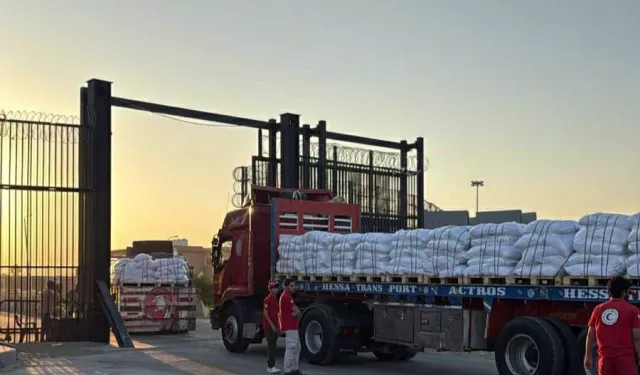For one Palestinian woman, the journey to the aid entry point in Gaza was born of a double tragedy.
Having lost her husband in a prior Israeli strike, and with no source of income, she had to walk into imminent danger herself. “My children are starving,” she told Al Manassa. “No one is helping us. The trucks keep getting stolen. I have no choice but to chase after them myself.”
Despite narrowly surviving Israeli artillery shelling during the attempt, she ultimately received no aid, overwhelmed by the crush of people and the severely limited supply.
More than 120 aid trucks entered Gaza on Monday, but most were looted en route by armed gangs and intercepted by desperate civilians before reaching their destinations, according to a source from an international organization who spoke to Al Manassa.
The aid trucks, authorized by the Israeli occupation army, comprised 44 vehicles from Egypt and additional deliveries facilitated by international agencies. Their cargo included flour, various food supplies, baby formula, diapers, and other essential goods. Yet, only a fraction of these supplies made it to warehouses operated by humanitarian organizations.
“Most of the trucks were intercepted,” the source said. “People are hungry, and armed groups are taking advantage of the chaos.”
Eyewitnesses in different areas told Al Manassa that organized gangs attacked aid-seekers with knives to seize the largest share of supplies and resell them at inflated prices.
This violence was evident at Al-Quds Hospital in Gaza City, where a medical source confirmed receiving more than 70 people with stab wounds sustained during the looting of trucks in the Nabulsi neighborhood, southwest of the city.
In Khan Younis, another medical official at Nasser Medical Complex told Al Manassa that the Israeli occupation army “committed a massacre against aid seekers,” opening fire on people waiting for aid in Kaf Muraj, killing 35 and injuring over 40 with gunfire and shell fragments.
According to an eyewitness, the shelling and shooting began just as hundreds assembled Monday evening, waiting for the aid trucks. “They fired directly at us before the trucks even showed up,” the witness said.
The trucks were eventually allowed to pass through the site of the carnage, where survivors and the dead lay on the ground. Amidst the chaos, widespread looting of the aid supplies then took place.
This scramble for aid underscores the escalating humanitarian crisis in the Strip.
Gaza's population is suffering from famine worsening at unprecedented levels, according to Gaza’s Government Media Office, affecting 2.4 million people. So far, 133 starvation-related deaths have been reported, including 87 children.
Palestinians in Gaza are not only grappling with famine but also with near-daily assaults by Israeli occupation forces at aid distribution points. These attacks, ranging from live fire and airstrikes to documented orders for aid truck drivers to deliberately run over displaced individuals seeking food, have claimed hundreds of lives.
Engineering chaos
In northern Gaza, families and clans began organizing early Monday to protect convoys arriving via Al-Sudaniya area near the Zikim crossing. A journalist on the scene told Al Manassa that after these groups began guarding the trucks, Israeli occupation forces delayed their entry for hours, allowing them through only at dusk.
Shortly after, an Israeli drone fired on the clan-based guards at a traffic roundabout in Al-Sudaniya, killing 11 and injuring others. Naval forces also opened fire from the coastline.
“Then the trucks came in, but chaos followed,” the journalist said. “Israel created the perfect conditions for looting.”
Gaza's Media Office condemned the targeting of the guards, calling it “a clear and systematic example of the occupation’s deliberate and conscious effort to sow chaos, engineer famine, and prevent aid from reaching warehouses — and therefore those in need,” the office said in a statement viewed by Al Manassa.
“This constitutes a deliberate and ongoing crime against the besieged civilian population,” it added.
Escalating strikes
Meanwhile, Israeli air and artillery strikes intensified on residential areas in Khan Younis, killing around 40 people and injuring dozens. Several remain trapped under rubble, an ambulance worker told Al Manassa.
By early Tuesday, hospitals reported receiving more than 110 fatalities and dozens of injuries from airstrikes targeting homes and shelters in Gaza City and Nuseirat refugee camp.
On Sunday, the Israeli army had announced a limited “tactical pause” for humanitarian purposes, to be observed daily from 10 am to 8 pm in areas including Al-Mawasi, Deir al-Balah and Gaza City. The army said the move was coordinated with the UN and aid organizations.
However, Israeli operations resumed shortly after that announcement, targeting designated safe areas.
Israel resumed its military campaign on March 18 after walking away from a ceasefire agreement announced in January. The deal was expected to last until the end of its offensive on Gaza, which began on October 7.
Simultaneously, Israeli occupation forces imposed a siege on Gaza, blocking the entry of humanitarian aid to the Strip.
As Gaza’s humanitarian crisis deepened in recent days, calls to reopen the Rafah border crossing surged on social media. The Egyptian government, however, continues to insist the crossing remains open on its side and has not been closed at any point during the Gaza crisis. Meanwhile, control of the Palestinian side of the crossing has been in the hands of Israel since May 7, 2024.
On Monday, Egyptian President Abdel Fattah El-Sisi said Cairo has been working with Qatar and the US since Oct. 7, 2023, to end the war, facilitate aid and “broker a hostage release deal.”
